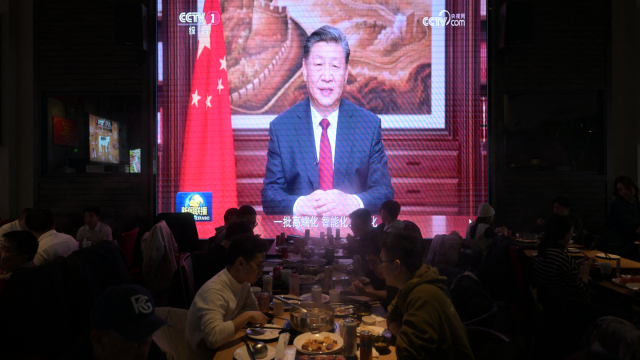While the world discusses the unprecedented rise in gas prices in Europe, another energy crisis is unfolding on the other side of Russia’s borders. In China, electricity shortages have forced several provinces to effectively introduce power rationing. At the end of September, the Chinese authorities asked the Russian power generator Inter RAO to increase supplies to China.
It seems that the transition over to green energy will not only change the market conditions for Russian hydrocarbon exporters in Europe, but in China, too. In China’s case, however, it will likely create more opportunities than problems.
The electricity deficit in China has been caused by regional governments scrambling to bring emissions of carbon dioxide and other greenhouse gases in line with the limits set on them. A year ago, the Chinese leader Xi Jinping pledged that China would be carbon-neutral by 2060, and the first to feel the pressure are the country’s coal-fired power stations, which still play a key role in Chinese energy production.
In recent weeks, nineteen major Chinese provinces have started rationing electricity. Energy-intensive industries such as the manufacturing of metals, cement, and chemicals have been almost universally affected.
The current crisis has three main underlying causes. The first is a spike in energy commodity prices on global markets amid the post-coronavirus recovery. That includes the price of coal, which is still the main fuel used at China’s power plants. The increase in prices has coincided with a decrease in China’s own coal production, since many coal mines have closed in recent years as a result of tougher environmental standards.
The second cause is that by the end of the third quarter of 2021, many Chinese provinces had realized that they were not on target to meet the environmental recommendations issued by Beijing. They therefore set about trying to reduce emissions using radical methods, such as requiring enterprises to limit their energy consumption.
Thirdly, while power generation may be growing, in some Chinese regions, especially in the southeast, it still lags behind demand. Some aluminum producers, for example, are in such a hurry to reduce emissions by moving over to hydroelectric power that there are not enough new hydroelectric stations to meet demand.
China’s energy infrastructure is simply not ready for such a concerted effort to curb emissions, which opens up new opportunities for Russian hydrocarbon exporters.
Oil and gas currently account for over 60% of Russia’s exports to China, and Beijing’s push toward greener energy will likely only increase the role of hydrocarbons in bilateral trade. China is trying to gradually reduce its dependency on coal, but that’s not easy, given that the fossil fuel generates more than 67% of the country’s electricity. One possible replacement is gas: gas-fueled power stations produce half the emissions of greenhouse gases that coal plants do. Accordingly, Chinese demand for gas will double by 2035, forecasts McKinsey.
The development of Russian gas exports — both pipeline gas and LNG — to China could not, therefore, have come at a better time. The cheapest gas available to Chinese consumers as of January 2021 was that supplied via the Power of Siberia pipeline launched in 2019. There are already plans for a Power of Siberia 2 championed by Russian President Vladimir Putin.
Russia also began supplying LNG to China in 2019. While it is currently only the sixth biggest exporter of LNG to China, that’s a significant start. With Chinese investment, loans, and even equipment increasingly featuring in new LNG projects in the Russian Arctic (Yamal LNG and Arctic LNG 2), Russian exporters are more or less guaranteed a prize spot in the world’s biggest gas market over the next decade.
One of the more controversial parts of Beijing’s low-carbon agenda is the move over to so-called green coal: energy-efficient coal considered to be a compromise solution in the early stages of the energy transition.
As long as coal plays a key role in Chinese energy, Russian exporters have another window of opportunity. In 2020, China was the biggest importer of Russian coal, accounting for 15% (29.4 million tons) of all Russian coal exports—though China still imported more coal from both Australia and Indonesia.
One of the obstacles to increasing Russian coal exports to China is the poor transport infrastructure in Russia’s Far East. To solve this problem, Russian Railways announced plans this year to modernize the Baikal–Amur Mainline and Trans-Siberian Railway at a cost of about $10 billion over three years.
The Baikal–Amur Mainline is planned to be extended toward the Elga coal mine, the biggest in Russia’s Yakutia region. It so happens that the coking coal found there, with its high energy value, fits the criteria for the “green coal” that China is so keen to use. In 2020, the mine’s operator, Elga Coal, formed a joint enterprise with China’s GH-Shipping and began delivering coal to China, supplying 15–18 million tons this year. From 2023, the supplied volume is due to reach up to 30 million tons.
The development of Russian coal exports is a relatively successful example of how the state and businesses have managed to adapt fast enough to the market and its biggest consumer. Given the high quality of Russian coal, demand for it in China will be sustained even during the country’s transition over to green energy.
Another part of China’s plans to reduce emissions consists of moving over to electric and hybrid vehicles. They are expected to account for 20% of sales of new cars by 2025 (up from 5 percent today), and up to 50 percent by 2035.
China’s transition to electric vehicles could make a dent in global demand for oil. According to forecasts by Sinopec, one of China’s biggest energy companies, Chinese oil consumption will peak in 2026, after which it will fall. Shifting to electric cars could save China $80 billion on importing oil over the next ten years, according to some estimates.
That’s not great news for Russia, as China’s biggest supplier of oil since 2013. No major new Russian-Chinese oil projects have emerged in the last few years. It’s true that for now, on the back of post-pandemic recovery, China is still increasing its consumption of oil, but in the future, the transition to green energy doesn’t bode well for Russian oil on the Chinese market. It should, however, increase demand for other energy commodities from Russia, such as high-energy coal and natural gas.
The current energy crisis shows just how paradoxical the transition to green energy in China will be. On the one hand, Beijing needs to guarantee the country’s energy security, and therefore buy more coal. On the other hand, it needs to reduce its dependency on coal-fired energy and move over to gas-powered electricity plants. Both of these imperatives create new opportunities for Russian exporters of energy commodities.
This article was first published by the Carnegie Moscow Center.
A Message from The Moscow Times:
Dear readers,
We are facing unprecedented challenges. Russia's Prosecutor General's Office has designated The Moscow Times as an "undesirable" organization, criminalizing our work and putting our staff at risk of prosecution. This follows our earlier unjust labeling as a "foreign agent."
These actions are direct attempts to silence independent journalism in Russia. The authorities claim our work "discredits the decisions of the Russian leadership." We see things differently: we strive to provide accurate, unbiased reporting on Russia.
We, the journalists of The Moscow Times, refuse to be silenced. But to continue our work, we need your help.
Your support, no matter how small, makes a world of difference. If you can, please support us monthly starting from just $2. It's quick to set up, and every contribution makes a significant impact.
By supporting The Moscow Times, you're defending open, independent journalism in the face of repression. Thank you for standing with us.
Remind me later.








